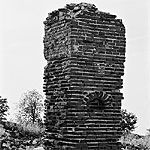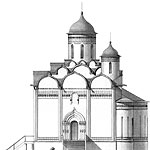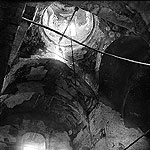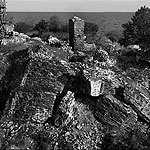 | ||
The Saviour Transfiguration Cathedral of the Kamenny MonasteryThe north-east view. The cathedral was exploded in 1927. A photo of the 1920s  The Kamenny MonasteryIt is situated on an island measuring only 8.5 sq. km in Kubenskoye Lake Search | ||
 |
|
The Saviour Kamenny (Spaso-Kamenny) Monastery. The Saviour Transfiguration Cathedral. 1481
It is the oldest cloister in Belosero, 137 older than the St. Cyril Belozero Monastery. The Kamenny Monastery was founded in 1269 by the Grand Prince of Belosero Gleb Vasilkovich who vowed to do so during a storm at Kubenskoye Lake which was notorious for shipwrecks. It was on a small islet of the same name measuring only 120 by 70 metres and located in the north-east of the lake that a monastic community started.
The Tales of the Kamenny Monastery that was compiled by a remarkable elder (starets) Paisy Yaroslavlov referred to the work executed by Dionisy in the Kamenny Monastery in 1481.
The tales recounted that the Grand Prince of Uglitch Andrei Vassilievich Senior gave to his younger brother, the Grand Prince of Vologda Andrei Vassilievich Junior the whole tier of the Deesis icons.
The Deesis painted by Dionisy consisted of at least three icons: Jesus Christ flanked by the Theotokos and John the Baptist. According to the 1670 inventory of the Kamenny Monastery, the Transfiguration Cathedral Deesis already had 13 icons.
Neither the Saviour Transfiguration Cathedral nor the Deesis icons of the Kamenny Monastery pertaining to Dionisy have survived.
 The North-western Pillar of the Saviour Transfiguration Cathedral of the Kamenny Monastery |
Under the Grand Prince of Moscow Dmitry Donskoy the monastery was managed by Hegumen Dionisius, a Mount Athos monk who later became the archbishop of Rostov. He introduced the monastic charter of Mount Athos and shaped traditions that established prestige, authority and glory of the monastery for centuries to come. The setting of the cloister on a tiny island created proper conditions for renunciation and absorption in prayer. According to the strict monastic rule women were completely barred from the monastery and the baths were removed to sandbanks now named after them.
Just as many other northern cloisters the Kamenny Monastery also served as a prison for political and religious figures in disgrace. The significance of the Kamenny Monastery among other Russian monasteries can be judged from the fact that its hegumen was the 24th to sign the document on the foundation of the Moscow Patriarchate in 1589, much ahead of all the Vologda hegumens.
The monastery was often struck by fires. In 1476, the then wooden cloister burnt to the ground. Two years later the appendage Prince Andrei Junior, brother of the Russian Tsar Ivan III, started constructing a new stone Saviour Transfiguration Cathedral that was finished in 1481. It was the first monumental cathedral to be built in the Russian North. Rostov, the centre of the monastery’s eparchy, supplied architects and masons.
Below is the description of the cathedral’s architectural style by contemporary art historians: “The Saviour Transfiguration Cathedral which was built, when the reconstruction of the Moscow Kremlin was in full swing, was a four-pillar, three-apse cross-domed church typical of middle Russia of the second half of the 15th century. Its cube, crowned with three rows of corbel arches (kokoshniki) and domes had a system of torispherical vaults with gradually ascending arches”.
This type of church, created in the architectural style of middle Russian principalities, notably Moscow, Rostov and Tver, evolved from the old Vladimir-Suzdal architectural traditions in the 14th -15th centuries.
Though similar to Moscow architecture, the cathedral of the Kamenny Monastery had a number of particular features that contributed to the development of Belozero’s church architecture.
 The Saviour Transfiguration Cathedral of the Saviour Kamenny Monastery |
The cathedral on the Kamenny Island was two-domed. It had another small cupola on the south-eastern corner that marked the side-chapel (the southern apse). Such tradition of additional domes over chapels inscribed into one of side-chapel apses that stemmed from old Moscow churches (e.g. the Church of the Virgin Nativity with the Lazarus Side-chapel and the second church of the Chudov Monastery with the Annunciation Side-chapel in the Moscow Kremlin) later became the feature of Vologda-Belozero region.
The facades of the northern cathedral were richly ornamented with patterned bands on the plinth, top of the walls, altar apses and dome drums. The bands were made up with diapers, dice, glazed terracotta tiles and balusters. These motifs can be found in a number of Moscow cathedrals of the time (the Holy Spirit church (1476-1477) of the Trinity St. Sergius Lavra, the church of the Deposition of the Robe in the Moscow Kremlin (1485-1486), the 1509 Nativity Church in the Old Symonov Monastery). Yet, the decoration of the Kamenny Monastery fused to form a pronounced local pattern so characteristic of the Saviour Priluki Monastery.” (G. Bocharov, V. Vygolov The Saviour Kamenny Monastery).
185 years later, the monastery suffered another severe fire that destroyed the church vessels, icons, vestry and library as well as all the wooden constructions and resulted in the vaults tumbling down and the bells melting. However, the cloister was soon reconstructed as the economy was booming.
 The Saviour Transfiguration Cathedral of the Kamenny Monastery |
On 24 June 1774 a third major fire took place through the fault of one of incarcerated convicts who was later declared insane. But it was already an altogether different era: Peter’s reforms were over; Catherine II issued the Regulation (Manifest) on secularization of the church property, lands and peasants. The cloister that numbered only 15-20 monks was downgraded to the third category state support that excluded any chance of self-financed restoration. Therefore, the decree of the Supreme Synod abolished the Kamenny Monastery.
For 26 years the monastery lay in desolation. But in 1801 the local merchants and peasants petitioned and funded its renewal. It would have turned into a typical provincial cloister with rich past and modest present if it had not been for its new ‘mission’. It literally became ‘the life-saving place’ as the first and only in the province lifeboat station of the Imperial Russian Society for life saving upon water was opened on the island.
A lighthouse in the form of a powerful oil lamp encased in a glass construction was erected on the roof of the cells. Its light was seen for 20 miles away in good weather and for 4 miles if the weather was bad. A special bell was cast at a St. Petersburg foundry and delivered to the island in order to give signals when there was a fog or a snowstorm.
Once again the Saviour Kamenny Monastery was closed in June 1925. Hegumen Anatoly and five monks were ordered to look for elsewhere to live. The monks’ cells were handed over to the Provincial Department for people’s education and converted into a settlement for juvenile delinquents. The latter arrived in July but in September a new fire occurred. The assembly building, refectory and belfry burned down. The walls and vaults as well as the roof of the Transfiguration Cathedral collapsed again. Only one of the five domes survived. The juvenile delinquents were moved to another place.
In 1937, the Saviour Transfiguration Cathedral was blown up as the authorities needed bricks for the construction of a House of Culture but never managed to get any because the large, hand- made blocks would not come apart.
In 1998, to the south of the island where the Church of the Dormition partly survived, a belfry was erected and consecrated in the name of all Vologda saints. In the middle 1999, the regional administration added the Kamenny Monastery to the restoration plan. At present it is being officially transferred to the Orthodox Church.
The Bishop of Vologda and Veliky Ustyug Maximilian served a liturgy that was attended by pilgrims from Vologda and Moscow. Shortly before that the Bishop and Hegumen Dionisy consecrated the cross raised to the bell-tower and conducted the service at the height of around 30 metres. The Orthodox cross crowned the oldest in the Russian north cathedral anew.
The revival of the monastery started at the end of the 80s and beginning of the 90s when Alexander Nikolaevich Pligin began the restoration of the cloister. Until his death in 2004 he devoted all his energy and resources to the Kamenny thus attracting sponsors and helpers.
Nowadays the Trust of the Kamenny Monastery is being formed. The town church of the Saviour Priluki might be instituted here in future. Alexander Pligin’s work is continued by his widow Nadezhda Ivanovna who thinks that “the priority of the restoration works is to preserve the bell tower which might collapse any minute. The bell tower is old, of the 16th century, there is substantial destruction and cracks resulted from the explosion and time”.
In 2005, the local government of Vologda region appropriated 200,000 rubles for the reconstruction. Another source for today’s restoration is charitable contributions, although “they are as difficult to forecast as the island weather”, as Nadezhda Pligina once remarked.
Experts know of around ten cathedrals whose walls were painted by Dionisy. Some of the painter’s works are lost for good; some have been preserved by restorers
Only the wall painting of the Virgin Nativity Cathedral of the St. Ferapont Belozero Monastery has survived in full and intact |
|
According to historical documents, the following works of Dionisy (the dates indicate the year of their painting) are known:
 Ruins of the Saviour Transfiguration Cathedral of the Kamenny Monastery |
|
|
 |
SUPPORTING WITH:
| |||||||||||||








